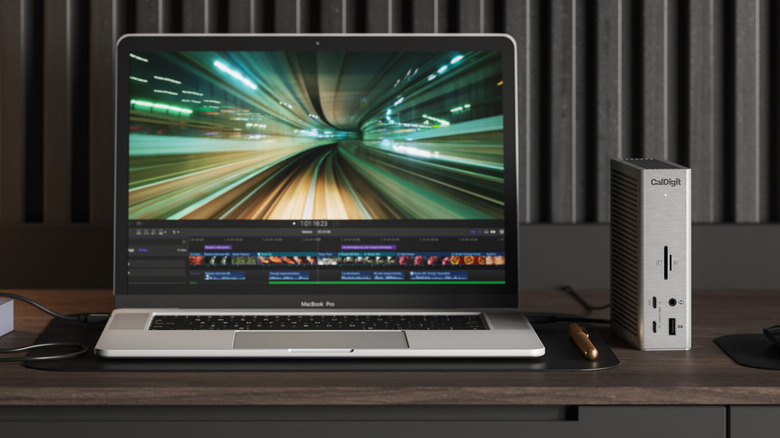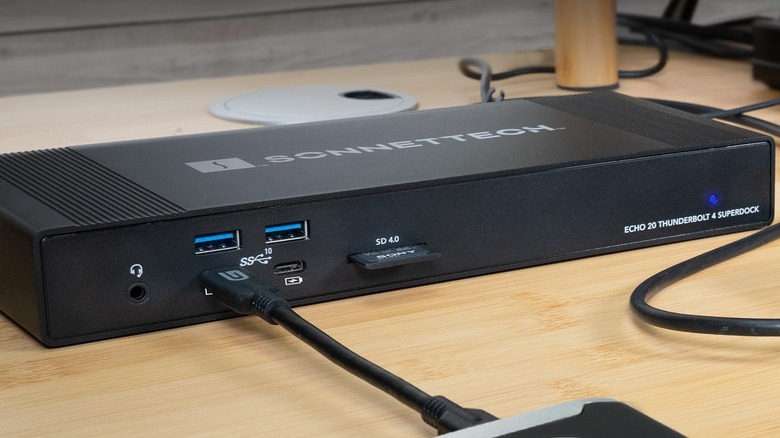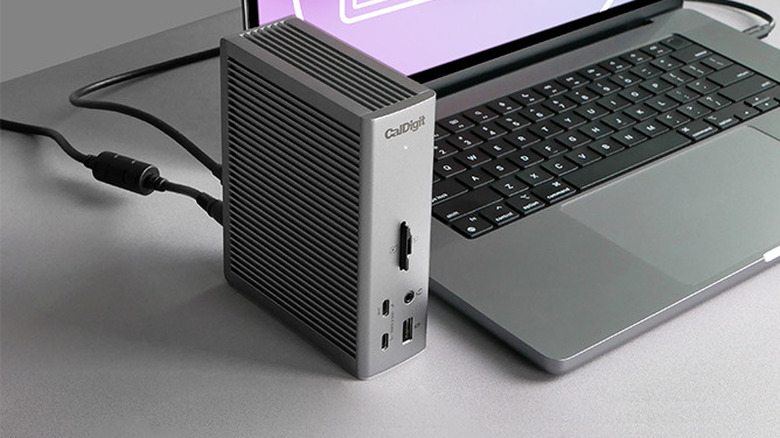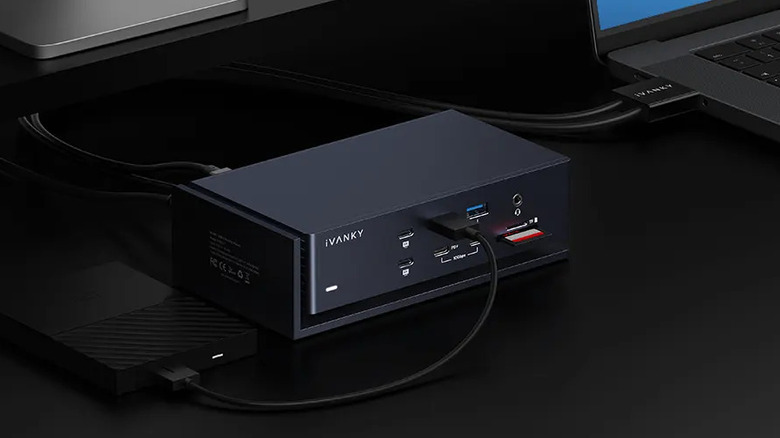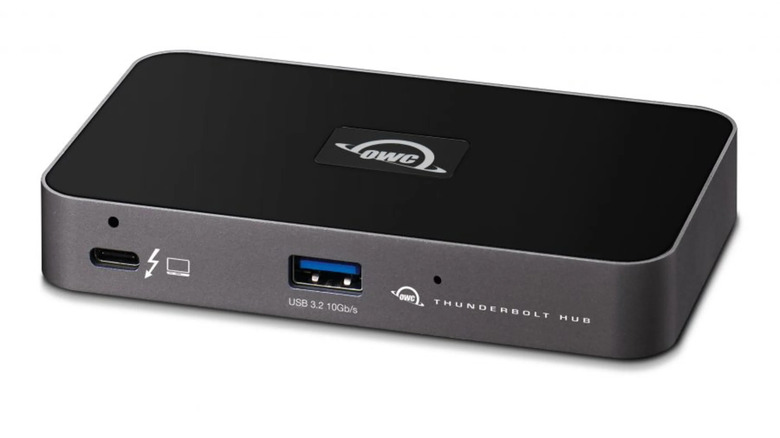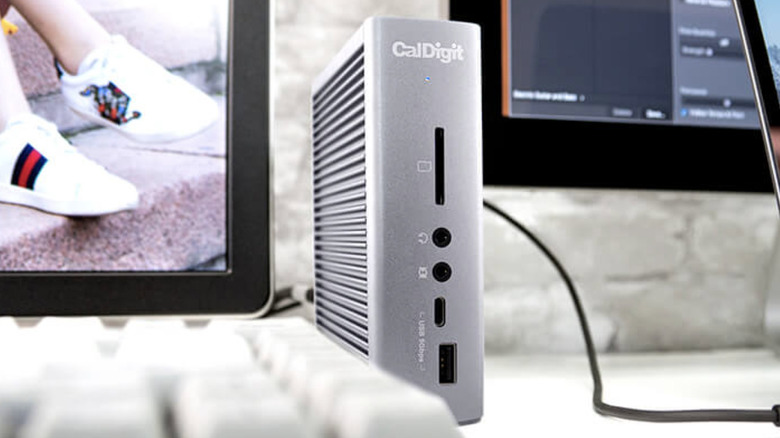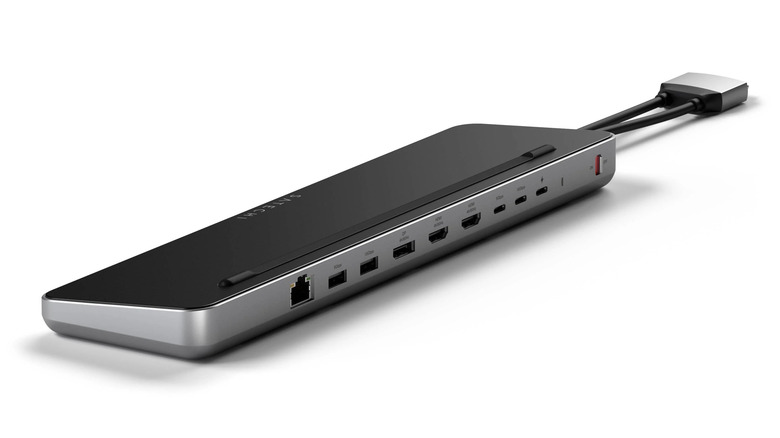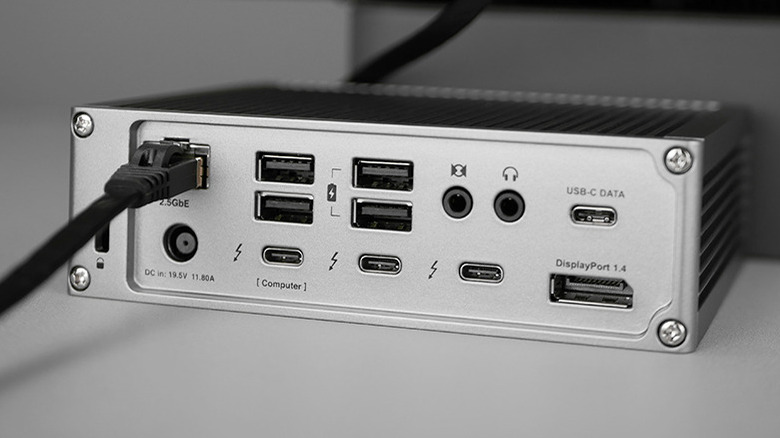6 Of The Best Docking Stations For Your MacBook Pro
We may receive a commission on purchases made from links.
As the MacBook Pro has evolved, it has many things to love. There have been upgrades to displays, operational power, battery life, memory, and storage. If you were to go back to a MacBook Pro from 15 years ago, you would be amazed at the progress that has been made in creating what is still one of the most desired laptops on the market. The current MacBook Pro is not perfect, however, and is missing a few things that we used to take for granted on the older models, for example, connector ports. Whether they be USB ports, an Ethernet port, or even a FireWire port (remember FireWire?), the sides of the MacBook Pro used to give you many options to plug in different devices.
Currently, the base MacBook Pro features two Thunderbolt 4 ports, a SDXC card slot, and an HDMI port. That is incredibly restricting if you have various displays and drives. Plus, it cuts out the ability to use older forms of connectors, like USB-A or hardwiring your internet connection with Ethernet.
So, people have had to turn to docking stations to increase their MacBook connection abilities. Finding the right docking station can be a little daunting if you aren't familiar with what kind of ports you may need. After consulting reviews from publications and customers alike, here are six different docking stations for your MacBook Pro that can satisfy a variety of connector needs, as well as budget ranges.
Sonnet Tech Echo 20 Thunderbolt 4 SuperDock
That latest technology in connector ports for the MacBook Pro is Thunderbolt 4. Although the connector looks identical to previous generations of Thunderbolt ports as well as USB-C ports, Thunderbolt 4 is able to transmit 40 Gbps in both directions. To maximize the Thunderbolt 4 ports on your MacBook Pro, you will want a docking station that connects via Thunderbolt 4, and arguably, the best on the market for most people with large MacBook setups would be the Sonnet Tech Echo 20 Thunderbolt 4 SuperDock. Retailing for $299.99, this dock gives you an incredibly wide variety of connectors to plug your devices into that run at top performance, earning 5-star reviews from both Macworld and Apple Insider.
In total, the Echo 20 Thunderbolt 4 SuperDock has 19 different ports for your devices, which is astounding. Not only does this include two downstream Thunderbolt 4 ports, but there are also four USB-A ports and four USB-C ports — both of which are USB 3.2 Gen 2 connections. However, that's not all, as it is also equipped with an Ethernet port, an HDMI 2.1 port, left and right audio out jacks, and separate jacks for a microphone and headphones. Whatever device you have, this docking station is bound to have a port for it.
The only downside to the Echo 20 Thunderbolt 4 SuperDock is that it can only handle 100W of power delivery. A MacBook Pro has its own charging port, but if have a device that requires a lot of power to operate or charge, you could run into a little trouble.
CalDigit Thunderbolt Station 4
One reason people might need a docking station is because they want to connect their MacBook Pro to an external display. Whether for gaming, video editing, or just having a larger screen, external monitors have become a popular device for many. The aforementioned Sonnet Tech Echo 20 Thunderbolt 4 SuperDock is able to connect to an external monitor either through its HDMI or Thunderbolt 4 ports; however, you may have noticed that there is one port missing: a DisplayPort, one of the most popular connectors for external monitors, particularly for gamers. This may not be on the dock from Sonnet Tech, but you can find it on the CalDigit Thunderbolt Station 4.
In many respects, this docking station is a very similar to the Sonnet Tech. Although it features one less port — namely one less USB-C port — it features all the other port types that you could want. It also supports 98W of power delivery for charging, a marginal step down.
The biggest difference from the Echo 20 is that the CalDigit dock has the DisplayPort 1.4 connection rather than an HDMI. Whatever external monitor you have will determine which kind of connection you require, and if it needs a DisplayPort and you have the Echo 20, you are out of luck. The CalDigit Thunderbolt Station 4 does cost quite a bit more at $399.99, but you are still getting a very highly rated docking station.
iVanky FusionDock Max 1
One or two external monitors is not an uncommon setup for many people using a MacBook Pro. However, there are some setups out there that require the use of even more monitors at a very high resolution. While the previous two docks are pretty good for displays, there are even more powerful options, such as the iVanky FusionDock Max 1 with dual-Thunderbolt connectivity. Among its 21 ports — a truly staggering number — are a few different ways to achieve different high-resolution monitor setups to satisfy just about anyone needing larger screens.
Most notably, the FusionDock Max 1 has the ability to connect four monitors at once that are all displaying 6K images. These monitors will require a USB-C connection to achieve this, but if you are a film editor or music producer, having that kind of setup could be a serious game changer for your work. If your monitors require HDMI instead, the FusionDock Max 1 does have two HDMI ports, though these are only able to max out at 4K displays. It also features all the other customary ports you'd expect and 96W of power delivery.
In order to achieve that 6K four-screen setup, your MacBook Pro needs to have a Max processor. Some models just have Pro processors, and these can only support two screens. The FusionDock Max 1 isn't for everyone and is quite expensive at $439.99, but for those who are power hungry, it's a great choice.
OWC Thunderbolt Hub
All the docking stations mentioned thus far have been for people with elaborate setups, but not everybody who has a MacBook Pro requires four monitors, multiple external hard drives, and the ability to charge their iPhone and iPad simultaneously. Some people just need a couple extra ports and a dock that is relatively lighter on the wallet. You shouldn't need to spend several hundred dollars just to have a few more port options. That is where something like the OWC Thunderbolt Hub comes in handy.
Available for just $139.99, this docking station still utilizes the Thunderbolt 4 technology that the others use to connect to your MacBook Pro, but it has drastically fewer ports available. On one side, you have a Thunderbolt 4 connection that goes to your laptop, alongside one USB-A port for a device with the older technology. On the other side, there are three Thunderbolt 4 ports and the plug for the power cord. This is a much smaller device than the previous docking stations, so if portability is important to you, then this is also a great option for a travel dock.
As a power source to charge your laptop, it may be a little light, as it can deliver just 60W of power. However, because the MacBook Pro has its own designated power port next to its Thunderbolt 4 ports, this shouldn't be much of an issue unless you are limited with wall outlets.
CalDigit TS3 Plus
Although the MacBook Pro utilizes Thunderbolt 4 technology, that doesn't necessarily mean that every device you want to plug into your laptop requires that level of connection. You could very well be in a situation where the top level you need is just Thunderbolt 3, and there are a good number of Thunderbolt 3 docking stations available on the market. Going in this direction will also save you a bit of money, as it isn't the most current technology. Out of all the Thunderbolt 3 docks out there, the one you are probably going to want to pair with your MacBook Pro is the CalDigit TS3 Plus.
In many ways, the CalDigit TS3 Plus is a lot like the previously mentioned CalDigit Thunderbolt Station 4, which is the next generation of this docking station. It does have fewer ports available than the newer option — 15, compared to the Station 4's 18 — but that is still more ports than most people know what to do with. You still get five USB-A ports, two Thunderbolt 3 ports, two USB-C ports, an Ethernet port, and a DisplayPort 1.2 for your external monitor needs.
The power delivery to your laptop maxes out at 87W, which is a step down from the newer model, but that should still be enough to adequately charge your laptop if a wall outlet isn't available to charge it separately. The CalDigit TS3 Plus retails for $239.99, so if Thunderbolt 3 is all you need, why not enjoy the discount?
Satechi Dual Dock Stand
There are even better deals out there for a docking station if you are willing to forgo Thunderbolt ports. Remember that USB-C connectors are nearly identical to Thunderbolt connectors, so you can easily plug them into your MacBook Pro. However, the connection speed will be capped at what the USB-C can perform, which is lower than Thunderbolt. If USB-C speed is fine with you, then purchasing a docking station that uses a USB-C connection will allow you to save even more money. For $149.99, your best option for this is the Satechi Dual Dock Stand, which utilizes a dual USB-C connection to your MacBook Pro.
In total, nine ports are available, including both USB-C and USB-A ports and an Ethernet port. Out of all the docking stations on this list, this is the only one that features two HDMI ports and one DisplayPort 1.4 on the same device, all of which are compatible with 4K external monitors.
There's also an SSD enclosure on the bottom of the dock that supports NVMe and SATA SSDs, which can handle data transfer speeds up to 10 Gbps and 6 Gbps, respectively. The design of the device also lets it fit perfectly underneath the back of your MacBook Pro, almost like it was built into the laptop.
Although it does have a power delivery of 75W for your laptop, the USB ports unfortunately are not able to charge devices like the other docks on this list. Other than that, and its lack of a Thunderbolt connector, there is not much to complain about this docking station at this price.
Why these docking stations were chosen
So many companies have produced docking stations for modern-day laptops like the MacBook Pro because they know that there has been a significant reduction in the number of ports for people to connect their devices. Quite frankly, this list could be much longer than it is to fulfill every niche need that a person who requires a docking station has. Narrowing things down to just six meant cutting out many quality devices in order to find some kind of consensus as to what really are the best out there. Primarily, this was done by drawing from personal experience with certain docking stations and stacking them up against various publications well-versed in the ways of technology to find the best reviewed models, such as Macworld, Apple Insider, and Mac Rumors.
From there, a wide range of options needed to be showcased. Each docking station needed something unique about it that made it stand out. This could be the number of ports available, what kind of ports it used, or how much power it was able to generate. Variety didn't stop there, as there also needed to be spotlights for different kinds of connections that the MacBook Pro is able to support. Finally, a wide range in pricing was utilized because not everyone who is looking to purchase a docking station has the same budget. Once all these factors were taken into consideration, these six products were chosen for the list.
